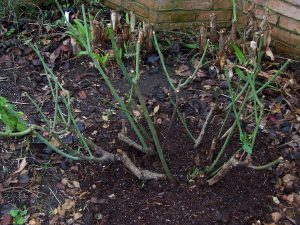February can be a confusing month for North Florida gardeners. Winter isn’t over. So, don’t let spring fever cause you to make some gardening mistakes. Let’s take a look at some dos and don’ts of February gardening.
Despite colder temperatures that we can experience this month, it’s still okay to plant trees and shrubs from containers. The roots are better protected in the ground and will quickly grow outward to establish as compared to being exposed to cold temperatures above ground, confined in a container. But be cautious about planting cold sensitive tropical plants too soon while freezing weather is likely. Bare-root trees and shrubs should be in the ground promptly. This includes bare-root nut and fruit trees, pine and hardwood tree seedlings and bare-root roses. Dormant season planting allows time for establishment before hot weather arrives.
February is a good time to transplant or move trees and shrubs that are in the wrong place. Consider moving plants that require pruning to force them to “fit” into small or confined spaces. Move them to an appropriate location where they can grow to full size. Then you can plant something new and appropriately sized for replacement. Of course, they need to be reasonable in size to move.
Late February is a good time to prune overgrown shrubs such as ligustrum and holly. These plants usually respond well to severe pruning, if necessary. But remember, they will eventually regrow to their larger size. Prune to shape and thin broadleaf evergreens and deciduous flowering trees such as oleander, crape myrtle and vitex. Avoid severely pruning narrow leaf evergreens such as junipers because they have few buds on old wood from which to form new growth. Mid-February is a good time to prune bush roses, removing dead or weak canes. Leave several healthy canes and cut these back to about eighteen inches. Delay doing much pruning on early spring flowering shrubs such as azalea until shortly after they flower. Pruning these plants now will remove present flower buds before they can open. Prune deciduous fruit trees such as peach, plum and apple. Now is also the time to prune ornamental grasses such as muhly grass.
If your lawn has a history of problems with summer annual weeds such as crabgrass, apply a preemergence herbicide. This should be done February 15 to March 1 when day temperatures reach 65° to 70°F for 4 or 5 consecutive days. A second application may be needed eight weeks later. Many people fertilize their lawns too early. Wait until mid-April to fertilize to prevent lawn injury and for the most efficient use of the fertilizer.
- Nuisance Gnats abound in Northwest Florida this spring - June 26, 2025
- Watering to Establish a New Lawn - May 15, 2025
- Sweet Onion and Strawberry Success, a Matter of Variety and Timing - April 10, 2025

